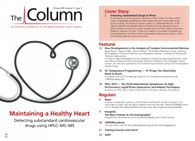Palaeolithic Poisons Analysis
A new study hopes to highlight that poison was used as far back as 30,000 years ago. Dr Valentina Borgia, a specialist in Palaeolithic hunting weapons and Marie Curie Fellow at the McDonald Institute for Archaeological Research at the University of Cambridge, is using liquid chromatography combined with mass spectrometry (LC–MS) to analyze prehistoric weaponry.
Photo Credit: Photos by RA Kearton/Getty Images

A new study hopes to highlight that poison was used as far back as 30,000 years ago. Dr Valentina Borgia, a specialist in Palaeolithic hunting weapons and Marie Curie Fellow at the McDonald Institute for Archaeological Research at the University of Cambridge, is using liquid chromatography combined with mass spectrometry (LC–MS) to analyze prehistoric weaponry.1
Dr Borgia told The Column: “Within Palaeolithic studies, many questions concerning hunting weapons and the efficiency of the spears/arrows enhanced with stone armatures or bone elements remain unanswered. Recently, useâwear analysis and experimental archaeology have provided new insights into the use and effectiveness of hunting weapons, and now archaeological science methods may help us to further reconstruct the kinds of long range hunting techniques used during the Palaeolithic and the role spears/arrows played in these pursuits.”
The difficulty of analyzing these samples has meant that progress has been slow up until now. Alongside Michelle Carlin, a forensic scientist from the University of Northumbria, Borgia was able to formulate a method using cotton soaked in pure water, which meant that there was no damage to these fragile samples. They were able to test samples taken from museums in Rome, Oxford, and Cambridge and identify residues of poisons on the objects. Borgia told The Column that LC–MS was of significance to this study. She said: “The application of LC–MS to try to identify plant poisons on hunting tools from the Palaeolithic period is important as working on samples that are so old brings with it challenges when it comes to interpretation of data.”
Small plant samples were provided by Alnwick Gardens to use as reference standards and an extensive search of the scientific literature on the analyses of plant poisons was made. “An initial method was established to analyze swabs of the artefacts from museums for the presence of plant poisons such as the Aconitum plant (Monkshood),” Borgia said. “The biggest challenge was finding an appropriate sampling method which would effectively ‘extract’ any of the plant poisons from the hunting tool without damaging the museum item.”
The group are now focused on analyzing six arrow-heads, dating from 4000 BC, from the Phoebe A. Hearst Museum of Anthropology in the USA. The initial tests on the arrows suggest the presence of acokanthera, a North African plant that is commonly used in arrow poisons. They are also creating a database of toxic plants. She added: “Very soon, with a rich database on which we can count on and a strong methological approach, we will be
able to analyze the first Palaeolithic samples coming from some important European sites.” - K.M.
Reference
1. http://www.cam.ac.uk/research/features/poisons-plants-and-palaeolithic-hunters

Polysorbate Quantification and Degradation Analysis via LC and Charged Aerosol Detection
April 9th 2025Scientists from ThermoFisher Scientific published a review article in the Journal of Chromatography A that provided an overview of HPLC analysis using charged aerosol detection can help with polysorbate quantification.











